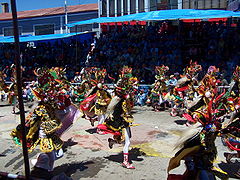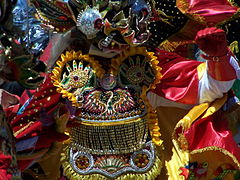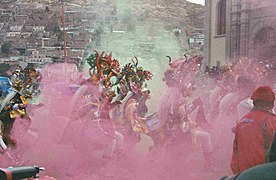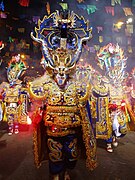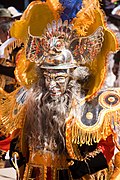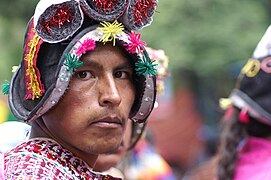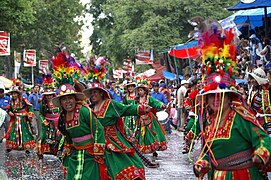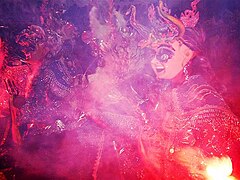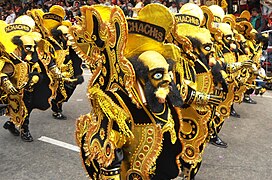Background
The native Itu ceremonies were banned by the Spanish in the 17th century, during their rule over Upper Peru. However, the Uru continued to observe the festival in the form of a Catholic ritual on Candlemas, in the first week of each February. Christian icons were used to conceal portrayals of Andean gods, and the Christian saints stood in for other minor Andean divinities. The ceremony began forty days before Easter.
Legend also has it that in 1756, a mural of the Virgin Mary miraculously appeared in a mineshaft of the richest silver mine in Oruro. Ever since the Carnival has been observed in honor of the Virgen de la Candelaria (Virgin of the Candlemas) or Virgen del Socavon (Virgin of the Mineshaft). The most important elements of the Carnival now occur in and around the Sanctuaria del Socavon (Church of the Mineshaft).
Pre-Hispanic period
Called Jururu (Uru Uru) in ancient times, the area that is now Oruro was a religious pilgrimage center of the Andean world. Pilgrims would trek to the "Sacred Mountain of the Urus", where they could call protective deities: wak'as, achachilas and apus. These deities included Jamp'atu Qullu (hill toad), Argentillo Arankani (hill lizard), Quwak (viper), the condor and Wakallusta, among others. After the Incan Empire expanded to the region, the culture expanded as well. This could be understood through the addition of an evil demigod, WariDesam, and a sacred demigod, Apus waka.
Spanish colonization led to the breaking down of the indigenous native legacies. However, many indigenous rites were preserved by the inhabitants, giving rise to a religious syncretism of Catholicism and Wari Culture. Christian ideas of the Virgin and the Devil from Catholic teachings were absorbed into native ideas of Pachamama and Tio Supay, a blending of religious symbolism that can still be seen during the Carnival.
Modern carnival
The modern festival demonstrates the ongoing pagan-Catholic blend of religious practice in the region. The carnival starts with a ceremony dedicated to the Virgen del Socavon. Marching bands compete simultaneously in the grotto of Pie de Gallo on Sunday, which is the greeting to the Virgin. The highlight of the festival is the three-day-and-three-night parade of 48 groups of folk dancers over a four-kilometer route to the sanctuary of the tunnel. Three days prior to this Saturday pilgrimage, people visit the symbolic pagan condor. A week after the pilgrimage, they visit the snake south of the city, the toad to the north, and the ants to the east.
Pilgrimage culminates in enacting two medieval-style didactics or mystery plays. The first is about the Spanish conquest and the other revolves around the classical battle between good and evil, with the Archangel Michael ultimately triumphing over the Devil and the Seven Deadly Sins. The last play was introduced by Catholic clergy in 1818.
In all, there are over 28,000 dancers, about 10,000 musicians in 150 bands, and 400,000 visitors stretching over four miles. The bands themselves have a national festival on the Monday before Carnival weekend, that is aired on Bolivian television and is attended by the President of Bolivia and government authorities.

The demographic characteristics of the population of Bolivia are known from censuses, with the first census undertaken in 1826 and the most recent in 2012. The National Institute of Statistics of Bolivia (INE) has performed this task since 1950. The population of Bolivia in 2012 reached 10 million for the first time in history. The population density is 9.13 inhabitants per square kilometer, and the overall life expectancy in Bolivia at birth is 68.2 years. The population has steadily risen from the late 1800s to the present time. The natural growth rate of the population is positive, which has been a continuing trend since the 1950s; in 2012, Bolivia's birth rate continued to be higher than the death rate. Bolivia is in the third stage of demographic transition. In terms of age structure, the population is dominated by the 15–64 segment. The median age of the population is 23.1, and the gender ratio of the total population is 0.99 males per female.

In the Quechua, Aymara, and Inca mythologies, Supay was both the god of death and ruler of the Ukhu Pacha, the Incan underworld, as well as a race of demons. Supay is associated with miners' rituals.

Oruro or Uru Uru is a city in Bolivia with a population of 264,683, about halfway between La Paz and Sucre in the Altiplano, approximately 3,709 meters (12,169 ft) above sea level.

Andean music is a group of styles of music from the Andes region in South America.
The music of Bolivia has a long history. Out of all the Andean countries, Bolivia remains perhaps the most culturally linked to the indigenous peoples.
Peruvian music is an amalgamation of sounds and styles drawing on Peru's Andean, Spanish, and African roots. Andean influences can perhaps be best heard in wind instruments and the shape of the melodies, while the African influences can be heard in the rhythm and percussion instruments, and European influences can be heard in the harmonies and stringed instruments. Pre-Columbian Andean music was played on drums and string instruments, like the European pipe and tabor tradition. Andean tritonic and pentatonic scales were elaborated during the colonial period into hexatonic, and in some cases, diatonic scales.
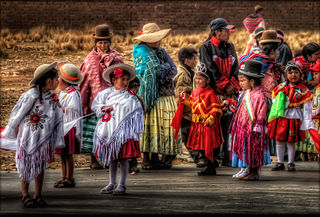
Bolivia is a country in South America, bordered by Brazil to the north and east, Paraguay and Argentina to the south, Chile to the west, and Peru to the west.

Oruro is a department of Bolivia, with an area of 53,588 km2 (20,690 sq mi). Its capital is the city of Oruro. According to the 2012 census, the Oruro department had a population of 494,178.
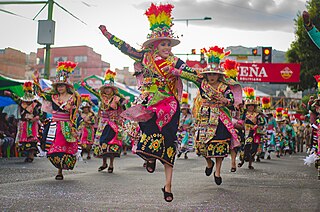
Tinku, a Bolivian Aymara tradition, began as a form of ritualistic combat. In the Quechua language, it means "meeting-encounter". During this ritual, men and women from different communities will meet and begin the festivities by dancing. The women will then form circles and begin chanting while the men proceed to fight each other; eventually the women will join in the fighting as well. Large tinkus are held in Potosí during the first few weeks of May.
The folkloric dance of the Tobas speaks of the ancient past of Bolivia. It has roots in a time when the Incas were the predominant force in the Andean highlands region. Tobas is an athletic dance comprising agile steps accentuated with many jumps and bounds.

The Caporales is a traditional Andean dance originated in Los Yungas of La Paz. Caporales were created and presented to the public for the first time in 1969 by the Estrada Pacheco brothers, who were inspired in the character of the 'Caporal' who is the overseer of the black slaves and was usually mixed race, wore boots and held a whip, a dance that belongs to the region of the Yungas, Bolivia The dance, however, has a prominent religious aspect. One supposedly dances for the Virgin of Socavón and promises to dance for three years of one's life. Caporal or caporales today is a folklore dance very popular in the festivities of not only Bolivia, but also Argentina, Chile, Peru, Spain and the United States.
The Fraternidad Folklórica y Cultural Caporales Universitarios de San Simón was founded in Cochabamba, Bolivia on November 22, 1978 by a group of residents from Oruro, Bolivia, alumni of the "Universidad Mayor de San Simón", for the purpose of retaining and growing its ancient customs. This group of youths decided to create a dance group of Caporales as a means to demonstrate their devotion to the Virgin Mary of the Socavón as well as to be able to participate in the Carnival in Oruro. For this reason, the "Universidad Mayor de San Simón" gives them support as it considers them a positive representation of Bolivian folklore.

The Kullawada, kullahuada, cullaguada or kullawa is a dance practiced in Bolivia and Peru and there is controversy about the origin of the dance between Bolivia and Peru. The name of the dance derives from the word kullawa, in reference to its dancers. In Bolivia, kullawada is danced mainly in the Carnaval de Oruro, the Fiesta del Gran Poder, the Festividad de la Virgen de Urkupiña and the Festividad de Chutillos. In Peru the dance is represented in the Fiesta de la Candelaria.
The Morenada is an Andean folk dance whose origins are still under debate. This dance is practiced mainly in Bolivia as well as in Peru and in recent years with Bolivian immigration in Chile, Argentina and other countries.

The Diablada, also known as the Danza de los Diablos, is an Andean folk dance performed in Peru the Altiplano region of South America, characterized by performers wearing masks and costumes representing the devil and other characters from pre-Columbian theology and mythology. combined with Spanish and Christian elements added during the colonial era. Many scholars have concluded that the dance is descended from the Llama llama dance in honor of the Uru god Tiw, and the Aymaran ritual to the demon Anchanchu, both originating in pre-Columbian Bolivia

The Son de los Diablos is an Afro-Peruvian dance that developed as a mixture between African, Spanish, and Amerindian rhythms. Nicomedes Santa Cruz explains that, despite popular opinion, the Son de los Diablos has no links with African rituals or with the Andean Morenada, but rather it has a very slight similarity with the Diabladas of Oruro (Bolivia).
The Saya is a music and dance that originated in Los Yungas-Chicaloma Bolivia. The artform's name comes from the Kikongo term nsaya, which means communal work led by a singing voice, akin to a work song. The Saya's instrumentation and dance also reflects the influence of traditional Andean music.

Bolivians are people identified with the country of Bolivia. This connection may be residential, legal, historical or cultural. For most Bolivians, several of these connections exist and are collectively the source of their being Bolivian.
